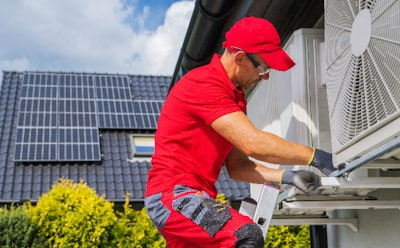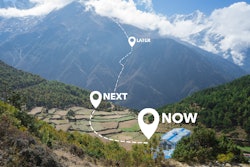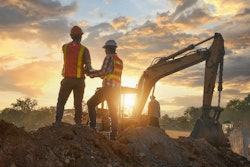
Construction field service management organizations including trade contractors and construction equipment maintenance organizations—are vulnerable to a skills gap that might be addressed by AI. This problem is being addressed directly by a number of construction technologies, including XOi’s all-in-one communication tool, Blitzz and Streem as well as by a throng of field service management software transactional systems for construction.
In December of 2023, IRONPROS debriefed a product team from Aquant, an artificial intelligence (AI) product that is used to extend operational software including field service management software and computerized maintenance management systems used in construction. Customers include construction-sector nameplates including Schneider Electric, Comfort Systems USA, Cummins and others. Frequent integration partners include IFS, SAP, Microsoft Dynamics, Salesforce and Oracle.
According to the study, available for download as of January 9th, 2024:
- Top-performing organizations are pulling further ahead of their lower-performing peers, mainly due to a smaller workforce skills gap. Best-in-class organizations have:
- Higher First Time Fix Rates across the top and bottom-performing employees.
- Lower service costs compared to industry averages and only a smaller cost difference between top and bottom performers.
- More time (in days) between visits, indicating fewer visits for repair and maintenance issues.
- Top-performing organizations have more equality in service costs across teams.
- On average, bottom performers cost 34% more than the highest performers at top ranking service organizations.
- The lowest-performing organizations have the most expensive workforce gap.
- Here, an organization’s lowest-performing employees can cost 80% more than the topperforming employees. It’s typically even higher in the bottom range of this group.
Our wide-ranging conversation with Aquant Senior Vice President of Presales and Customer Success Edwin Pahk shed light on these findings and provided a glimpse into the Aquant offering. Here is a condensed treatment.
IRONPROS: So from a construction standpoint, it looks like you're dealing with service organizations servicing off road equipment used in construction, trade contractors and other folks doing equipment installs, or aftermarket service as part of a contract?
PAHK: For the benchmark report, really, we cover quite a wide variety of industries. If you look at our report it’s definitely in that industrial machinery place, which has a few construction equipment manufacturers, to kind of just give you a couple of names, one of our biggest customers is a major equipment OEM. So skid steers, tractors, you know, a lot of these types of machines do fall in relation to kind of what we're looking at, and how we are able to service these different types of organizations. But we cover a wide variety of other industries in industrial manufacturing. When we combine and look at all this data, we try to identify key trends, and especially key metrics as it relates to the top types of problems our customers like to measure and understand more broadly as to how they're performing so they can more effectively deliver service.
IRONPROS: What are some of the impediments that they're facing where they are getting tripped up?
PAHK: Yeah, I think the number one impediment that most every single organization that we speak to today is facing is a labor shortage or technician shortage. In our interactions with different customers, technicians don't stay technicians for as long as they used to. So the model in which you have a 15- to 20-year expert within your organization that has seen every problem under the sun and can solve each one, those tricky problems as it relates to the equipment now is being replaced by people that stick around for maybe a couple of years. As a result, companies are struggling with dealing with the departure of a lot of that tribal knowledge that was used to help solve a lot of those complex problems. And they're looking at trying to identify technology solutions to be able to help fill that gap to get people that are coming in new to the industry up to speed faster, as well as the disseminate some of that expert tribal knowledge across multiple mediums. And I think specifically in the construction equipment space. This is particularly felt because a lot of construction equipment manufacturers primarily have service in the aftermarket through dealerships. So it's not company badged employees that are doing most of the servicing out there. And so that also creates a second degree disconnect of that experience. And I think that ultimately is one of the major driving factors for a lot of these organizations looking to identify technology to be able to solve that gap, as there's this shift in what we're seeing from the workforce.
IRONPROS: Yeah, these are all familiar trends in field service management. But what are some new insights or approaches people can take folks can take using Enterprise technologies that can begin to ameliorate this stuff?
PAHK: There's a couple of key things here. Part of it is also the evolution of where technology is today. If you look back 15 years ago within the industry, obviously everyone was talking about digital transformation—this idea of going from pen and paper to digitizing work and what is being done. Now, organizations are evolving into taking all of that digitized data and turning it into something useful, something that can represent a way to educate and coach individuals on how to actually do something more so than just having to record every single transaction that’s done. The nuance of all this is that these organizations that have gone through this digital transformation strategy over the last few years now are in a place where they can unlock a lot of experience that is stored in that data into something that and turn that into something that's more meaningfully operationalized for individuals, like technicians in an organization.
IRONPROS: So here, here's, here's something I'll throw open for you. We’re talking like, you know, some days, you know, a couple of other days, like four or five, yeah, construction technology entities a day. Including the computerized maintenance management system (CMMS), enterprise asset management software and fleet management space. What I’m really seeing is a lack of predictive maintenance stuff coming from the service history of individual machines or classes of machines. We see some cool predictive analytics capabilities coming from Cummins that comes from intelligent components. But what I’m not seeing is predictive analytics or prescriptive recommendations driven by the service history. Chances are there are insights in there. What are you guys seeing on that front?
PAHK: It’s interesting. And I think it does depend on the type of organization and the amount of data that you have around this. I'll give you an example. Construction equipment manufacturers that have dealerships as their primary aftermarket service model, unfortunately, don't have visibility into the entire service history of that asset, right? And so because they don't, it's difficult for them to build a predictive model off of incomplete information. A lot of what a lot of these companies are trying to do is figure out how we get access to that data, so that we can ultimately build more effective models around maintenance, specifically, because a lot of the times a lot of these manufacturers will only get warranty claims. That's the best source of data in terms of what's going on in the field. How can I offer a solution that helps not only solve problems, but also be able to track better history around said assets? Right? Because once you have that history, then you can create much more predictive models around this.
The second thing is there are ways of being able to graduate into that slowly. For example, we have customers that are leveraging what we call our preventive maintenance effectiveness score. And the idea is, when I run a maintenance job, what was the result of that? Did it result in a higher time between repair--did it result in a longer time period between a failure and that maintenance visit? Or did it actually not do that? And you look at the concept of maintenance and effective maintenance as a measure of both time and touch—how many times did you touch the machine and what was the length of the period between those times and the effectiveness of that? …
I can tell you based off of our experience, some of the challenges around this are essentially just purely based off the fact that a lot of these OEMs are just trying to find ways of getting access to the data to build that effective model.
IRONPROS: With Cummins as the prime example, we are starting to see more interlacing of different components on a machine to provide a more sophisticated picture of what the condition the machine is, and if you're getting like a given code, what's going on in an ancillary components like a transmission or a fuel pump. What else is coming to help provide additional insight in terms of, you know, what the appropriate repair is going to be or other insights regarding how long a service can be pushed out?
What do you see the role of AI in parsing those multiple streams of data into something that that becomes more than the sum of its parts? And has some predictive value?
PAHK: I think it's a very interesting time right now, because for a lot of manufacturers a lot of these machines are already producing a lot of data—telematics error codes—coming from the machine on a streaming basis that allows you to at least have some form of a picture? The problem comes back to the interpretation of when and how these things are happening. There's actually an element of this where AI plays in a couple of areas? One of which is, of course, the ability to look at the sequencing of the signals that are coming from the machine.
There's actually a critical element that a lot of people are exploring, as it relates to observable symptoms at time of time of failure. And so, for example, let's say you have a machine, you get a check engine light on all of a sudden. Of course, you can drop the codes and pull the codes off using an onboard diagnostics (OBD) or something. But what actually ends up being most valuable for someone that's looking for the root cause is, is on top of the error codes, understanding was this machine driving uphill or downhill at the time. Was it breaking a lot of these types of signals, but the organization might not be capturing literally every single detail about the machine?
AI has a place here because if you look how the story is told around what's happening with that machine, a lot of that story is being told in unstructured comments and free texts and chat logs, and you name it, a lot of conversation. And it's about distilling out the key elements about what's being described there, and combining it with some of the machine data and signals that you're getting from that. That is where we see the true opportunity of combining all of these different elements and signals together in a way that paints the truest picture of what the problem is that and then allows AI to then interpret and recommend a solution based off of that. So. So it really is a multidisciplinary aspect of really kind of taking into account as many different parameters in the environment, you know, observable symptoms by the customer error codes coming from the machine, all of these different things, and then ultimately coming to a conclusion based off of that, and that's kind of where there's a big opportunity area for AI to start playing a larger role. So on top of your idea about maintenance history, what about the orientation of the machine? What was the machine doing at the time that the failure happened or the symptom was observed?
IRONPROS: So across a larger dealer organization or across a CMMS or fleet management solution that has maintenance within your organization, how can a team see for an equipment class or make/model, when there's like a given symptom, prescriptive maintenance solutions based on either the maintenance crew within your organization, or across everyone in a wider population.
PAHK: Using our solution, the OEMs have kind of boxed themselves in because they have their own maintenance solution for you to use on their equipment. Of course, you can't really effectively support a mixed fleet with that. So it's kind of suboptimal in a way, but talking about where AI could play a role is is good because it gets people people's gears turning in these sectors.
IRONPROS: What is Aquant doing right now, when it comes to AI to help increase the amount of intelligence and drive down some of the metrics like truck rolls, and driving up first time fix and stuff like that?
PAHK: It's a great question. And to your point, it's, it's funny, because it's like you said, you're surprised that you don't see more of it. And you think there would be considering kind of the opportunity value looking at how you're maintaining an asset holistically.
I think, for the most part one, people don't know what to do with the data that they have, that's the first thing. And two, they might not have enough data to be to be predictive. Just to give you an example, most everyone we've spoken to that's tried to do a predictive maintenance model, ended up prescribing way more maintenance. That ended up creating a much higher cost to service that machine than had they not done the extra two or three visits that the model was recommending.
Generally speaking, where we focus is creating the broadest possible understanding of what's going on with that machine at that point of failure and to be able to do more than articulate what the problem is. For example, a check engine light comes on and someone calls in and says they’ve got a problem with their machine to the fleet manager or to a shop. A lot of the times, depending on who you get on the other side of that phone or that technician, you might get a very different experience as it relates to how it's troubleshot. Some might ask if you were driving up a hill or driving down a hill. Others might just tell you to bring it into the shop. And so as a result, AI can kind of act as a co-pilot, guiding people trying to solve a problem, helping ask the right questions and finding the right information as quickly as possible.
Ultimately, we can then to achieve the most successful outcome for both customer and servicer, which is getting it done right the first time and extending the quality and the longevity of that asset.
A lot of where we play is really around this concept of using everything that you have in all the data that you've collected. What's in the mind of your best experts? One key thing about AI in this space that is different is that you’re making a prediction based off of what happened 80% of the time. You know for the most part, that's the right thing to do. In service, that's not always the case. In service, the best thing to do is oftentimes known just by one individual that's been doing it for 25 years and as a result just came up with a better way to solve that problem. That will never show up in the data. The ability to take that subject matter expertise, that tribal knowledge, and then ultimately allow AI to guide and ask the right questions, surfacing the right problems … this is ultimately where we see an opportunity to create the best service outcome for everyone.
IRONPROS: So if an organization We’ve got a group of equipment items, say, compaction equipment products, and they want to improve the lifecycle experience of customers, and drive down their investment in field service while increasing the quality of the owner experience what does that engagement look like? Is this like more of like a subscription to a solution? Is there like a consulting engagement to get set up … how much is this packaged, and how much of this is you becoming someone's friend and helping them out?
PAHK: I think it's a little bit of both but, but generally speaking, it is, it comes down to the fact that we are providing a suite of technologies and products that ultimately will then lead to the outcome that they're looking to achieve. This new kind of this next generation of products that are being developed on this concept of AI is unlike products in the past. And what I mean by that is that the AI is in ultimately informed by the customer’s data. The customer’s data is ultimately a factor. We’re using the foundational technology that we have and creating a recipe of data, plus our technology ultimately, that leads to the end product.
So the outcome might end up being a little bit different for every single customer, which requires us to provide a deeper level of guidance and partnership with our with the companies that we partner with, to help them understand how to navigate through some of the noise that might exist in their data.

About the Aquant Solution
Pahk described how Aquant extends software used by teams in the field to help proactively spot problems and resolve them at lower cost using a Shift Left approach. This might include at the far left actual, problem prevention, proceeding self-service options, remote support and progressing towards rolling a truck and technician. The progression is from tactics that keep cost and time to resolution low towards costlier, more time-consuming approaches.
Aquant can leverage data from multiple sources to create summarizations of insights from manuals, captured tribal knowledge and other sources to create a question and answer engine that gets to root cause.
“And then to try to off ramp individuals in this interaction as quickly as possible,” Pahk said. “Because the faster you can do that, the better it is for the organization and the better experience that customer ultimately has. So it's a great win-win proposition for everyone.”
Aquant functionality addresses the needs of service leaders, the call center and service technicians across a modular product for the different personas.
“But in the end, it's one connected journey,” Pahk said. “You know, when, when a customer tries to search online because a pump’s broken, that feeds into the next step of the contact center agent, basically getting that context, and having the AI ask them questions. So it's ultimately a single intelligence offered in very specific personas that we can mix and match where exactly you want to create the impact in your organization.
Aquant Pricing and Market
Aquant is a fit for organizations servicing or manufacturing complex equipment. Enterprise-size organizations are often a fit due to the amount of data they may have collected or have access to.
“We also have a facility and ability to handle situations when there is no data,” Pahk said. “And that happens with our customers, because they launch a new products. There is no data, no service history data around that, right? How do you approach those kinds of scenarios? I would typically say though, if you're a you know, a generally a sizable manufacturer of equipment somewhere in the, you know, $100 million range and above, you know, is usually a pretty good fit.”
The market according to Pahk would extend to large engineer, procure construct (EPC) contractors and large mechanical contractors.
Pricing is based on the number of stock keeping units (SKUs), models and families of products the solution addresses and the functionality used. Typical customers are paying in the low six figures annually.
BOTTOM LINE: Aquant is an example of AI-as-a-service (AIaaS) solutions making their way to the construction sector. These are not transactional systems where business is managed, but capture and optimize, extend or add value to these systems to create new value from existing data. In a construction environment, this type of technology is coming to scheduling, identificaton of risk, go-no-go decisions and more. While automating transactional processes or field operations with AI is being done in some scenarios, AI technologies like those offered by Aquant that distill data into insights will probably carry lower risk and higher reward into the intermediate future.












